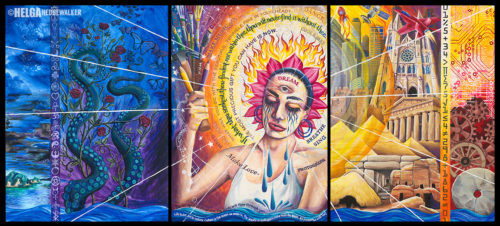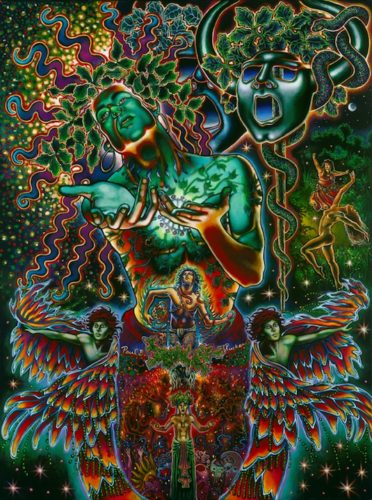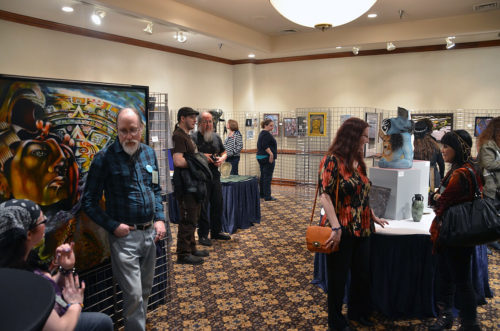MINNEAPOLIS – The Third Offering Gallery art exhibit at Paganicon takes its name from the belief that there are, as blogger Steven Posch is quoted as saying, “three traditional offerings of gratitude to the gods – water (for life), food (for sustenance), and beauty (to feed the soul).”
Helga Hedgewalker, a Gardnerian high priestess and Witch who founded the Third Offering art show in 2013 with Pagan and fellow professional artist Paul B. Rucker, wishes there were more awareness, if not gratitude, for Pagan creators of all sorts.
“It can be very tiresome how every TV show, radio podcast, magazine article . . . looks to writers/authors as the only thought-leaders worth acknowledging in the Pagan community, as if no other skills or talents have merit,” Hedgewalker said. “Throughout most of human history, culture has been transmitted through the arts: painting, music, fashion, dance, theatre, song, chanting, beautifully made tools, sumptuous foods and drink . . . .
“Good ritual partakes of all of those things— not what is written in books. Let me be clear, an author can describe a ritual in a book, but that is not ritual. True magic is a sensual experience, where the cerebral and rational must be left behind. If we are to truly build a Pagan culture, then we need less authors and more artists, musicians, cooks and dancers. We need less talking about magic and more doing!” (She later added that those comments “may sound like I’m crabby about books, but that’s really not true. I love books.”)

Triptych of the Muse [Helga Hedgewalker].
Both Rucker and Hedgewalker, not surprisingly, believe art is a magical act – for themselves during the process of creation and, they hope, when viewers engage their works and those of other “visionary artists” (as they and other such creators often refer to themselves).
The belief that art is magical may be as old as art itself: the most famous of those 14,000-year-old Paleolithic cave paintings in France, according to britannica.com, is “a small image, both painted and engraved, known as the horned god, or the sorcerer. It depicts a human with the features of several different animals . . . . Its significance is unknown, but it is usually interpreted as some kind of great spirit or master of the animals,” and it and other paintings in the cave “may reflect the practice of magical ceremonies in the chamber.”
“Creative flow is its own transcendent state,” said Rucker, who along with Hedgewalker planted the seeds of Third Gallery when they held a two-person show at Paganicon in 2012. Friends since 1992, the duo also co-founded the Minneapolis Collective of Pagan Artists.
“Making art can be a form of deep meditation,” Rucker continued. “Sometimes the art-making trance becomes like lucid dreaming while awake. Mircea Eliade, the scholar of religions, described the shaman’s journey as a ‘round.’ The shaman goes from ‘here,’ the ordinary world, to ‘there,’ the spirit world or the other world, in order to receive a teaching, a vision, have a profound experience of a heightened reality. To complete the round, the shaman must return with a medicine, a teaching, or something that will benefit the community. This requires a technique ‘of ecstasy’ as he called it. It’s not so hard to go to the other world — people can take drugs or have altered consciousness in a number of ways. What’s much harder is bringing something back that can be shared.”
Rucker’s website includes his account of a vivid dream he had as a child, of a white stag “that took me to a moonlit grove, wild and rambling, filled with . . . the names of the gods and goddesses of the world. To stand anywhere in that holy place was to feel each divine personality completely. All were there, every divinity the human world had ever known, and the stag of the moon leading me on and on . . . . Even then I knew my task was to bring that magic back to this world, somehow, through making images.”
His need to make art, Rucker told The Wild Hunt, is “my method of acquiring a ‘technique of ecstasy’ so that the bits of sacred fire from the visionary plane could be held in something that others could engage with here, in this world.”
Rucker was initiated at 18 into “an eclectic Pagan coven, and I’ve been exposed to many different kinds of ritual and Pagan/Polytheist/Old Craft/Thelemic — you name it — metaphysical subcultures, and brings that experience to bear in his art.
“What feeds my soul in this arena is ecstasy and transformative magic. Not ‘belief merchandise’ and rubrics and long, talky discussions about the validity of ‘traditions,’ or ‘circle church.’ The purpose of public ritual, in my opinion, is not to feel all safe and comfy in a circle, but to create a vessel that can heighten reality, that can bring the wild magic of the other world into this one, that can properly prepare the ground for a god or goddess to be really present. I also see this as one essential purpose of Pagan art. Not the only one, but an important one.”

“Dionysus,” which was featured on the cover of the “Modern Primitives” issue of Green Egg in 1997 [Paul B. Rucker].
She recounted a spring equinox ritual in 2015: “The priestess had drawn down the goddess, and she turned to me and said, ‘I am the muse, and I demand you do a portrait of me for this new age.’ ‘Ummm, yes, my lady, but I do not know what you look like,’ I replied. ‘That does not concern me,’ she said very sternly. ‘You will do this or I will remove my many gifts and blessings from you until the end of your days.’ I was left quaking with fear, for I had no doubt that this had been a true geas laid upon me.”
For nine months Hedgewalker struggled and fretted to find inspiration. Even invoking her muse in ritual failed. “I was starting to despair,” she said. “What if she really did steal what was most precious to me for all my life? I questioned the essence of my very existence and purpose in life. Who am I if not your tool, oh muse?”
Inspiration finally came in a vision on New Year’s Day 2016, and Hedgewalker completed her “Triptych of the Muse” in time to exhibit it in July 2016 at a show presented by the Minneapolis Collective of Pagan Artists.
“The priestess who had originally drawn down the muse, back at the spring equinox in 2015, came to the opening,” Hedgewalker said. “She stood stock-still in front of the triptych for a long, long time. Then, with eyes that weren’t quite hers, she turned to me and said, ‘The lady is pleased.’ I barely made it out of the gallery before I collapsed in sobs, the waves of relief, exhaustion, euphoria, and sweet agony all mixing together. It was one of the happiest moments of my life.
“Usually I do my best work in a trance state, and when I can achieve that flow, I believe the gods make themselves known and I am merely a channel for them.”

The scene at Third Offering Gallery at Paganicon 2015 [Paul B. Rucker].
Hedgewalker’s upcoming book with Estelle Daniels, Color a Magick Spell, is subtitled “26 Picture Spells to Color and Manifest.” On Hedgewalker’s website, she says she hopes the book, due in May from Llewellyn, will help people “use art as a way to unlock their creative and magickal potential.”
Rucker mentions his interpretation of Melek Ta’us, the Peacock Angel, “a tutelary divinity of primary importance for the Yezidi of Syria, and for the Feri culture/current of witchcraft.” His image went viral on the internet, and responses to the painting led him to believe that people see it as “a true and authentic portal to the Peacock Angel.”
This year’s Third Offering show is themed “Fire and Ice” and will feature 55 pieces from 24 artists, said art show director Jason Neu. Paintings, fired clay, digital photos on metal and works in other media are included. Awards will be presented in the categories best representation of theme, guest of honor’s choice, people’s choice (chosen by ballot), and best in show. Many of the original works and smaller print versions will be available for sale. A meet-and-greet with the artists will be held at 6:30 p.m. on March 17.
As in past years, the show is juried, which means that a panel selects works to be exhibited from those submitted by artists. “The purpose of curation is not to exclude anyone,” Rucker said. “Third Offering is extremely inclusive, open to artists of every skill level and degree of professionalism.
“My main reason for a juried review process was to avoid the ‘rummage sale’ effect that I have often seen at science fiction cons, which often have ‘art shows.’ Because there is usually no curation whatsoever, people bring anything and everything, and thus the artwork presented does not integrate with itself. Curation, even on the most basic level, helps to cohere the show in a professional way.”
The Wild Hunt is not responsible for links to external content.
To join a conversation on this post:
Visit our The Wild Hunt subreddit! Point your favorite browser to https://www.reddit.com/r/The_Wild_Hunt_News/, then click “JOIN”. Make sure to click the bell, too, to be notified of new articles posted to our subreddit.